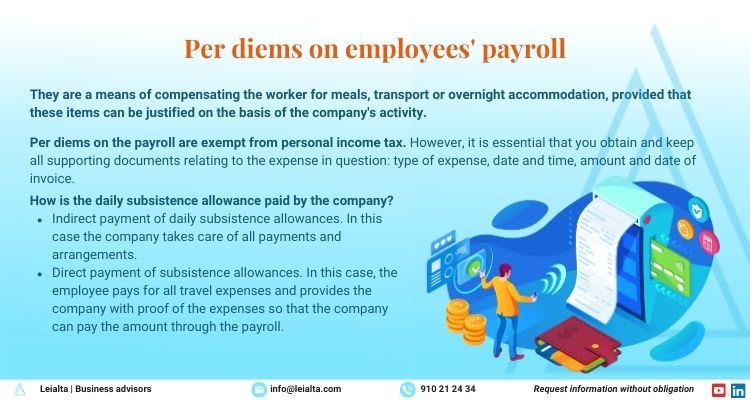
If any of your employees have to travel and you want to compensate them for the travel expenses, you will have to pay them an allowance. But how are allowances reflected in the payroll? Who is responsible for justifying the allowances? Are there any allowances exempt from social security contributions? In this article, we will address all these questions.
What are allowances in the payroll?
Index of contents
Allowances in the payroll appear as non-wage benefits, have a compensatory purpose and are a means of compensating the employee for meals, transportation or overnight stays, as long as these items can be justified on the basis of the company’s activity.
Specifically, allowances are regulated under Article 40.6 of the Workers’ Statute, which states the following:
For economic, technical, organizational, or production reasons, or due to contracts related to business activities, the company may temporarily relocate its employees, requiring them to reside in a different location than their usual place of residence, paying, in addition to salaries, travel expenses and allowances.
In addition to their salaries, the company shall reimburse travel expenses and provide allowances.
Furthermore, allowances are regulated in Collective Bargaining Agreements, as well as in the Personal Income Tax Law and Regulations.
Examples of payroll with work-related allowances:
- Allowances for mileage or travel expenses: public transportation passes, train, bus or plane tickets, gasoline, taxi receipts, parking fees, etc.
- Allowances for accommodation and lodging expenses: restaurants, hotels, apartments, etc.
Are allowances in the payroll exempt from contributions?
Allowances in the payroll, as mentioned before, are non-wage benefits and therefore are exempt from personal income tax (IRPF). As a result, the employee’s salary will increase along with their purchasing power.
However, it is essential to obtain and retain all receipts related to the expenses incurred, including the type of expense, date and time, amount, and invoice date. Both the employee and the employer should keep all receipts as the Tax Agency may request them for verification purposes. Additionally, the company must justify that the travel has been undertaken for work-related reasons associated with the company’s activities.
Regarding Social Security contributions for allowances, Article 147.2 paragraphs a and b of the General Social Security Law states that the following concepts will not be included in the contribution base:
- Allowances for commuting expenses of workers who travel outside their workplace when using public transportation.
- Allowances for commuting expenses not covered in the previous paragraph, as well as maintenance and accommodation expenses incurred in a municipality different from the place of work or the employee’s habitual residence.
As a result of the above, if the requirements we have seen are met, allowances are not included in the deductions from employees’ payrolls.
How are allowances paid by the company?
Allowances can be paid by the company in two ways:
Indirect payment of allowances: In this case, the company handles all payments and arrangements for airline tickets and employee accommodation. Direct payment of allowances: In this case, the employee covers all travel-related expenses and provides receipts to the company, which will subsequently reimburse the amount through the payroll. It is also possible to assign a daily amount for allowances to the employee, which will be included in each payroll.
How to monitor and manage your employees’ allowances? Human resources managers and business owners should know how to properly manage employees’ allowances, and for this, the following guidelines can be followed:
Establish an expense policy: This will provide clarity on how to manage each expense. You can establish the cases in which allowances will be paid, the method of justifying each expense, and the way in which allowances will be paid. Use a human resources management software: Allowance management can be automated using HR software that generates error-free payrolls. Collaborate with a business consultancy: A business consultancy like LEIALTA can provide you with a team of professionals in labor advisory services who will study your case, prepare payrolls, and include allowances as agreed with your employees.
In conclusion, allowances in payrolls are a way to compensate employees for expenses incurred due to business travel. It is important to control them to prevent excessive spending and ensure that each expense is properly justified with invoices and receipts.



